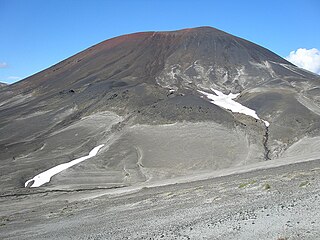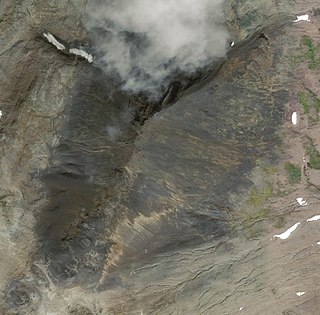Related Research Articles

The Northern Cordilleran Volcanic Province (NCVP), formerly known as the Stikine Volcanic Belt, is a geologic province defined by the occurrence of Miocene to Holocene volcanoes in the Pacific Northwest of North America. This belt of volcanoes extends roughly north-northwest from northwestern British Columbia and the Alaska Panhandle through Yukon to the Southeast Fairbanks Census Area of far eastern Alaska, in a corridor hundreds of kilometres wide. It is the most recently defined volcanic province in the Western Cordillera. It has formed due to extensional cracking of the North American continent—similar to other on-land extensional volcanic zones, including the Basin and Range Province and the East African Rift. Although taking its name from the Western Cordillera, this term is a geologic grouping rather than a geographic one. The southmost part of the NCVP has more, and larger, volcanoes than does the rest of the NCVP; further north it is less clearly delineated, describing a large arch that sways westward through central Yukon.
Tuya Butte is a tuya in the Tuya Range of north-central British Columbia, Canada. It is a bit less isolated from other ranges than neighbouring Mount Josephine. Some of the other volcanoes in the area include South Tuya, Ash Mountain, and Mathews Tuya.

The Spectrum Range, formerly called the Spectrum Mountains and the Rainbow Mountains, is a subrange of the Tahltan Highland in the Stikine Country of northwestern British Columbia, 20 km west of the Stewart-Cassiar Highway, south of Mount Edziza and north of the Arctic Lake Plateau. The Spectrum Range falls within Mount Edziza Provincial Park. The range is lightly glaciated, as compared to the other ranges to the west. It is accessible only by foot or via helicopter; there are no roads to the range.
Toozaza Peak is a tuya in the Stikine Ranges of the Cassiar Mountains in northern British Columbia, Canada, located in the Iverson Creek. Toozaza Peak is the summit of a north–south aligned ridge between the head of Toozaza Creek and the head of the Jennings River, just south of the Jennings' divide with the Little Rancheria River headwaters. The Little Rancheria and Toozaza Creek are part of the Liard, while the Jennings is part of the Yukon River drainage via Teslin Lake, and the peak therefore stands astride the line of the Continental Divide. It is part of the Tuya Volcanic Field, a volcanic field associated with the Stikine Volcanic Belt, part of the Northern Cordilleran Volcanic Province.

Cocoa Crater is a cinder cone in the Stikine Country of northwestern British Columbia, Canada. It is located 38 km southeast of Telegraph Creek and 8 m (26 ft) southwest of Mount Edziza. Cocoa Crater is one of the 30 cinder cones around the Mount Edziza complex that formed in the year 700. The ash around Cocoa Crater is quite deep, its summit is a jet black color and its summit is red. It is quite a different color from the brown color of Coffee Crater, which is to the south of Cocoa Crater.
Castle Rock is a volcanic plug located 13 km (8 mi) west of Iskut and 8 km (5 mi) northwest of Tuktsayda Mountain in British Columbia, Canada. Castle Rock is part of the Pacific Ring of Fire that includes over 160 active volcanoes and is in the Klastline Group of the Northern Cordilleran Volcanic Province and last erupted in the Pleistocene.
The Ash Pit is an inactive volcanic crater, located in the Spectrum Range in British Columbia, Canada. It is Holocene in age and is considered the youngest feature in the Spectrum Range volcanic complex. It is within the Northern Cordilleran Volcanic Province and is part of the Pacific Ring of Fire, that includes over 160 active volcanoes.

Nahta Cone is a cinder cone in northern British Columbia, Canada, located 69 km (43 mi) southwest of Tatogga, 9 km (6 mi) north of Wetalth Ridge and south of Telegraph Creek. It lies in the southwestern corner of Mount Edziza Provincial Park.

Wetalth Ridge is an isolated ridge in northern British Columbia, Canada, located 74 km (46 mi) southwest of Tatogga and south of Telegraph Creek. It lies on the southwest side of Little Arctic Lake at the southwest corner of Mount Edziza Provincial Park.
Pillow Ridge is a ridge of the Tahltan Highland in northern British Columbia, Canada, located southeast of Telegraph Creek. It extends northwest from Mount Edziza in Mount Edziza Provincial Park.
Outcast Hill is an isolated hill in northern British Columbia, Canada, located southeast of Mess Lake. It lies at the southern end of Mount Edziza Provincial Park.

Meszah Peak is a volcanic cone located 66 km (41 mi) north of Telegraph Creek and 136 km (85 mi) southwest of Zus Mountain in British Columbia, Canada. It is the highest peak of the Level Mountain Range, a cluster of bare peaks on the summit of the massive Level Mountain shield volcano, which forms the most voluminous and most persistent eruptive centre in the Northern Cordilleran Volcanic Province.
Chikoida Mountain is a mountain on the Taku Plateau in northwestern British Columbia, Canada, located 52 km (32 mi) southeast of Atlin on the east side of the Silver Salmon River.
The Neck is a mountain in northwestern British Columbia, Canada, located in Mount Edziza Provincial Park. It is a volcanic feature of the Northern Cordilleran Volcanic Province that formed in the past 1.6 million years of the Pleistocene epoch.
Second Canyon Cone, also called Canyon Creek Cone is a cinder cone in the Boundary Ranges of the Coast Mountains in northwestern British Columbia, Canada. It is a volcanic feature of the Iskut-Unuk River Cones which is part of the Northern Cordilleran Volcanic Province and formed in the past 10,000 years of the Holocene epoch.
Tadekho Hill is an isolated hill in the Northern Interior of British Columbia, Canada, located 64 km (40 mi) southwest of Tatogga and 10 km (6 mi) southwest of Kitsu Peak. It lies at the southwestern end of Mount Edziza Provincial Park.

The Mess Lake Lava Field is a volcanic field associated with the Mount Edziza volcanic complex of the Northern Cordilleran Volcanic Province in northwestern British Columbia, Canada. It lies northwest of the Spectrum Range on the Kitsu Plateau and consists of young basaltic lava flows and tephra. The source for the basaltic lava and tephra was three cinder cones, including Mess Lake Cone and The Ash Pit, which may be the youngest volcanic feature of the Mount Edziza volcanic complex.
Cone Glacier Volcano is a cinder cone in the Boundary Ranges of the Coast Mountains in northwestern British Columbia, Canada. It is part of the Iskut-Unuk River Cones group and last erupted during the Holocene period. Cone Glacier contains two arms that surround the volcano.

The volcanic history of the Northern Cordilleran Volcanic Province presents a record of volcanic activity in northwestern British Columbia, central Yukon and the U.S. state of easternmost Alaska. The volcanic activity lies in the northern part of the Western Cordillera of the Pacific Northwest region of North America. Extensional cracking of the North American Plate in this part of North America has existed for millions of years. Continuation of this continental rifting has fed scores of volcanoes throughout the Northern Cordilleran Volcanic Province over at least the past 20 million years and occasionally continued into geologically recent times.
References
- ↑ "Exile Hill". BC Geographical Names. Retrieved 11 April 2020.
- ↑ "Exile Hill". Catalogue of Canadian volcanoes. Archived from the original on 2011-06-04.